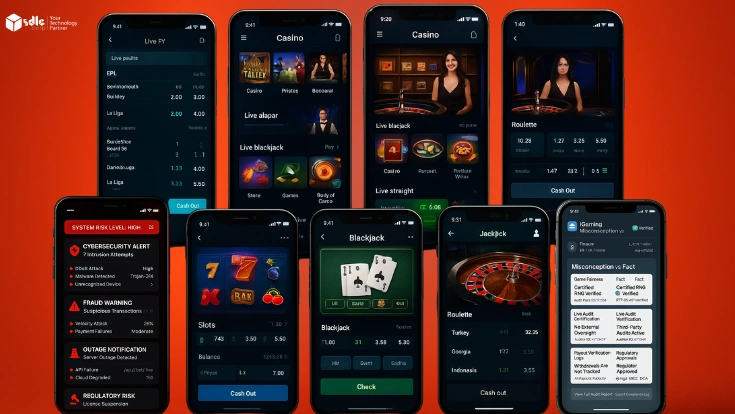In 2025, white-label online casino cost is straightforward: expect a one-time setup fee of $15k–$150k, a monthly platform fee of $5k–$50k, and a 10%–30% revenue share on NGR. Most turnkey casino launches go live in 4–12 weeks. This guide explains white-label casino pricing, how setup fees and rev share work, what add-ons cost, and how to choose the right package.
When you’re ready to compare offers, see our White Label Casino Solution and Turnkey Casino pages for scope and timelines.
What “White-Label” Really Includes (and Doesn’t)
What’s typically included
Hosted platform (turnkey back office, game aggregation, cashier/wallet).
KYC/AML & fraud basics (integrated vendors with per-check fees).
CMS/CRM basics (banners, simple segments, bonus presets).
Payments (a core set of card/APM rails supported by the provider).
Compliance templates (RG tools, age/geo checks, basic reporting).
Support (standard SLA, account manager, onboarding playbook).
What usually costs extra
Deep UI re-skins or custom components beyond theme variables.
Exclusive content or in-house games on top of aggregator titles.
Native iOS/Android apps (where allowed) vs. web/PWA only.
Advanced BI/segmentation (real-time traits, predictive scoring).
High-volume reporting/APIs (exports, data pipelines, warehousing).
Premium support (24/7, dedicated team, faster change windows).

White-Label Casino Pricing Models Explained
1) Setup fee + fixed monthly
The classic model: a one-time setup for branding, environment creation, and integrations; then a monthly platform fee tied to catalog size, support tier, and traffic band.
2) Revenue share vs. minimum guarantee
Revenue share (rev-share): 10%–30% of NGR. Lower shares are usually paired with higher setup/monthly fees or volume commitments.
Minimum guarantee (MG): a monthly floor against future rev-share, used to secure provider resources.
3) Per-game / per-provider add-ons
Live dealer, specialty game studios, or new aggregator hubs may be billed as add-ons.
4) Payments pricing
Per-transaction fees: card/interchange + gateway markup.
FX & cross-border: basis points on settlement.
Chargebacks: dispute fees plus operational overhead.
5) KYC/AML costs
Vendors charge per check (age/ID, sanctions/PEP, adverse media). Expect tiered pricing by volume and GEO.
6) Hosting/CDN & scaling tiers
Traffic bands (MAU/CCU) may trigger higher infra tiers. Edge/CDN egress is often metered.
7) Support & account management
Tiers range from standard business hours to 24/7 coverage with named CSM and technical concierge.
Line-Item Cost Breakdown (What to Budget)

Brand & design
Light skin (logo, palette, typography): often covered in setup.
Premium re-skin (custom header/footer, redesigned lobby/cashier): setup uplift.
Design system components: billed per component/scope.

Game catalog
Aggregator base tier: dozens to hundreds of slots/table games.
Live dealer: add-on with separate studio fees and certification steps.
Exclusive/early-access titles: premium priced.

Payments stack
Cards + APMs (e-wallets, vouchers, open banking): per-tx + gateway fees.
Crypto gateway (if allowed): extra KYC/chain-risk tooling; market-dependent.

Compliance toolset
Age/geo checks, RG features (limits, timeouts, self-exclusion).
Self-exclusion integrations (where centralized programs exist).
Reporting: regulator formats; export caps may apply at base tiers.
Marketing stack
Bonus engine (cash, free spins, ladders, wagering rules).
Affiliates (tracking, fraud controls, multi-touch payout).
Messaging (push/email/SMS) with deliverability & sender IDs per GEO.
Data & reporting
Dashboards (near-real time KPIs).
CSV/API exports (volume caps, rate limits).
CDP/warehouse connectors (often a premium add-on).
Here is a step-by-step overview of how a white-label online casino is launched:
- Initial Consultation: Define business goals, markets, and audience.
- UI/UX Design & Branding: Customize the look and feel based on your brand.

Jurisdiction & Compliance Considerations (Budgeting, not legal advice)
Market availability & pricing: Some providers limit or price differently by GEO. Live dealer studios and payment rails vary by region.
Pass-through fees: Certification, game approvals, or system reviews may be billed through to you.
Responsible-gaming workload: Reality checks, spend/time limits, self-exclusion programs, and ongoing reporting require ops time—budget for people, not just tech.
Data residency & retention: Expect different retention rules by GEO; higher-compliance markets may push you to higher platform tiers for controls and reporting.
1) Lean Starter (one GEO, light skin)
Setup: $15k–$40k
Monthly fee: $5k–$10k
Rev-share: 20%–30% NGR
Catalog: aggregator base tier (no live dealer)
Payments: 1–2 rails (e.g., cards + one APM)
Timeline: 4–8 weeks
Ops assumptions: small team (support + compliance on vendor playbooks)
Who it suits: proof-of-market launches, niche brands, pilot GEOs.
2) Growth Mode (2–3 GEOs, live dealer, CRM+)
Setup: $40k–$90k
Monthly fee: $10k–$25k
Rev-share: 15%–25% NGR
Catalog: aggregator + live dealer
Payments: 3–6 rails; reconciliation add-ons
Timeline: 6–10 weeks
Ops assumptions: dedicated CRM/affiliates; KYC/payments ops
Who it suits: brands targeting multiple regulated markets with stronger CRM and VIP.
3) Premium Brand (exclusive content, native apps)
Setup: $90k–$150k
Monthly fee: $20k–$50k
Rev-share: 10%–20% NGR
Catalog: aggregator + live dealer + exclusive drops
Apps: iOS/Android (where policy/regulation allows)
Timeline: 8–12 weeks (app store timelines vary)
Ops assumptions: in-house creative & VIP, agency support
Who it suits: well-funded teams aiming for premium UX and marketing firepower.
ROI & Breakeven Math (Simple Model)
A quick, auditable way to check if your white-label package pays back fast—and how sensitive it is to fees, bonuses, and game mix.
Key definitions
- GGR (Gross Gaming Revenue)
- GGR = stakes − player wins
- NGR (Net Gaming Revenue)
- NGR = GGR − bonuses − game provider fees − taxes (where applicable)
- Contribution after platform
- Contribution = NGR − rev-share − payment fees − platform monthly − KYC/fraud costs − ops
Worked example (Growth Mode)
| Item | Assumption | Amount (USD) |
|---|---|---|
| Setup | One-time onboarding | $60,000 |
| Initial marketing | Launch campaigns | $80,000 |
| Monthly NGR | After bonuses, provider fees, taxes | $120,000 |
| Rev-share (20%) | Provider share of NGR | − $24,000 |
| Payment fees (5%) | Gateway + FX + chargebacks | − $6,000 |
| Platform monthly | Fixed platform fee | − $15,000 |
| KYC/fraud costs | Per-check + device/risk vendors | − $4,000 |
| Ops | Support, CRM, compliance ops | − $10,000 |
| Monthly contribution after platform | NGR minus all platform-related deductions | $61,000 |
| Breakeven (months) | ($60k + $80k) ÷ $61k | ≈ 2.3 months |
Sensitivity: Heavier bonuses, higher payment fees, or a weaker game mix reduce NGR and push breakeven out. Use a CAC/LTV lens: if LTV − platform share − fees exceeds CAC, growth is healthy.
📊 Download the ROI & Breakeven calculatorVendor Shortlist & Evaluation Checklist
Commercials
Exact rev-share band and whether it steps down with volume.
Minimum guarantees, setup inclusions/exclusions, and overage triggers.
Data & ownership
Who owns player data and content rights?
Export formats/APIs, rate limits, and data retention policy.
Support for CDP/warehouse connectors.
Uptime & scale
SLA (uptime, response, resolution) and historic performance.
Traffic bands (MAU/CCU) and auto-scaling limits.
Compliance & security
Responsible-gaming features validated per GEO.
Pen-test cadence, audit evidence, incident response.
Product roadmap & lock-ins
Visibility on upcoming features and migration terms if you outgrow white-label.
Ability to add custom pages or embed tools without forking.
Implementation Timeline (4–12 Weeks)
Week 0–1: Branding & kickoff
Logo, palette, typography, domain setup, sandbox access.
Week 1–3: Integrations
Payments (commercial + tech), KYC providers, affiliate tracking, analytics tags.
Week 2–4: Content approvals
Aggregator catalog enablement; live dealer studio approvals where applicable.
Week 3–6: Data & CRM setup
Segments, bonus presets, reporting dashboards, API/CSV exports if needed.
Week 4–8: Compliance checks
RG controls verified; basic audits/evidence packs prepared.
Week 6–10: Soft-launch
Limited audience, real-money smoke tests, KPI monitoring.
Week 8–12: Full launch
Performance tuning, campaign rollout, affiliate activation.
Tip: Pre-book payment and live-dealer approvals; these often dictate the critical path.
Hidden Costs & Pitfalls
Single payment dependency: Build at least one fallback rail to avoid downtime.
Limited customization: Deep UI changes or unique flows may be outside SLA; confirm scope.
Data export limits: API/CSV quotas can block BI/CRM needs—check before signing.
Underestimating RG/compliance ops: Allow staff time for checks, reports, and player communications.
App-store risk (if using native): Policy and review times vary by region.
When Not to Choose White-Label
You need proprietary features, custom bonus mechanics, or unique game experiences.
You plan multi-brand, multi-region control with your own data pipelines.
You want to own wallet/ledger, bonus logic, and data end-to-end.
In those cases, consider custom development: Casino Game Development. Many teams still start on white-label, then phase into custom once traction and ROI are proven.
FAQ's
Can I migrate off a white-label later?
Yes—confirm export terms, notice periods, and content portability up front. Ask for a migration playbook.
Who owns the player data?
Policies vary. Negotiate data ownership and export rights (daily snapshots + API access) in the MSA.
Do I need my own license?
Some providers operate under their umbrella license for specific GEOs; others require your license. Clarify per market and budget for fees and checks.
How are bonuses treated in rev-share?
Most deals use NGR after bonuses; confirm definitions (bonus cost, game provider fees, taxes) to avoid surprises.
How are chargebacks handled?
You’ll pay dispute fees and operational costs. Good KYC, device/risk checks, and clear cashier UX reduce exposure.
What’s the typical contract length?
Commonly 12–36 months with renewal/step-down options tied to volume.
Can I use my own payment processors?
Often yes, but you may lose bundle pricing. Check integration effort and who owns the MID contracts.
How do timelines affect cost?
Not for launch. Many brands start with responsive web/PWA and add native apps later.
Is native mobile required?
Usually. White-label is often the lowest upfront route. Turnkey can cost more but reduces operational lift. Custom has the highest CAPEX and longest lead time. (This post focuses on white-label pricing only.)
How fast can I launch?
With focused scope and quick approvals: 4–12 weeks.
Where do I start?
See our White-Label Casino Solution for a scoping call and a tailored quote.















